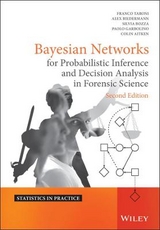
Bayesian Networks and Probabilistic Inference in Forensic Science
John Wiley & Sons Ltd (Hersteller)
978-0-470-09175-3 (ISBN)
- Keine Verlagsinformationen verfügbar
- Artikel merken
Contains a method for constructing coherent and defensible arguments for the analysis and evaluation of forensic evidence.* Written in a lucid style, suitable for forensic scientists with minimal mathematical background.* Includes a foreword by David Schum. The clear and accessible style makes this book ideal for all forensic scientists and applied statisticians working in evidence evaluation, as well as graduate students in these areas. It will also appeal to scientists, lawyers and other professionals interested in the evaluation of forensic evidence and/or Bayesian networks.
Franco Taroni - University of Lausanne, Switzerland Colin Aitken - University of Edinburgh, UK Paolo Garbolino - University IUAV of Venice, Italy Alex Biedermann - University of Lausanne and Federal Office of Police, Berne, Switzerland
Preface. Foreword. 1. The logic of uncertainty. 1.1 Uncertainty and probability. 1.2 Reasoning under uncertainty. 1.3 Frequencies and probabilities. 1.4 Induction and probability. 1.5 Further readings. 2. The logic of Bayesian networks. 2.1 Reasoning with graphical models. 2.2 Reasoning with Bayesian networks. 2.3 Further readings. 3. Evaluation of scientific evidence. 3.1 Introduction. 3.2 The value of evidence. 3.3 Relevant propositions. 3.4 Pre-assessment of the case. 3.5 Evaluation using graphical models. 4. Bayesian networks for evaluating scientific evidence. 4.1 Issues in one-trace transfer cases. 4.2 When evidence has more than one component: footwear marks evidence. 4.3 Scenarios with more than one stain. 5. DNA evidence. 5.1 DNA likelihood ratio. 5.2 Network approaches to the DNA likelihood ratio. 5.3 Missing suspect. 5.4 Analysis when the alternative proposition is that a sibling of the suspect left the stain. 5.5 Interpretation with more than two propositions. 5.6 Evaluation of evidence with more than two propositions. 5.7 Partial matches. 5.8 Mixtures. 5.9 Relatedness testing. 5.10 Database search. 5.11 Error rates. 5.12 Sub-population and co-ancestry coefficient. 5.13 Further reading. 6. Transfer evidence. 6.1 Assessment of transfer evidence under crime level propositions. 6.2 Assessment of transfer evidence under activity level propositions. 6.3 Cross- or two-way transfer of evidential material. 6.4 Increasing the level of detail of selected nodes. 6.5 Missing evidence. 7. Aspects of the combination of evidence. 7.1 Introduction. 7.2 A difficulty in combining evidence. 7.3 The likelihood ratio and the combination of evidence. 7.4 Combination of distinct items of evidence. 8. Pre-assessment. 8.1 Introduction. 8.2 Pre-assessment. 8.3 Pre-assessment for a fibres scenario. 8.4 Pre-assessment in a cross-transfer scenario. 8.5 Pre-assessment with multiple propositions. 8.6 Remarks. 9. Qualitative and sensitivity analyses. 9.1 Qualitative probability models. 9.2 Sensitivity analyses. 10. Continuous networks. 10.1 Introduction. 10.2 Samples and estimates. 10.3 Measurements. 10.4 Use of a continuous distribution which is not normal. 10.5 Appendix. 11. Further applications. 11.1 Offender profiling. 11.2 Decision making. Bibliography. Author Index. Subject Index.
| Erscheint lt. Verlag | 16.5.2006 |
|---|---|
| Verlagsort | Chichester |
| Sprache | englisch |
| Maße | 180 x 250 mm |
| Gewicht | 856 g |
| Themenwelt | Mathematik / Informatik ► Mathematik |
| Recht / Steuern ► Strafrecht ► Kriminologie | |
| ISBN-10 | 0-470-09175-4 / 0470091754 |
| ISBN-13 | 978-0-470-09175-3 / 9780470091753 |
| Zustand | Neuware |
| Haben Sie eine Frage zum Produkt? |
